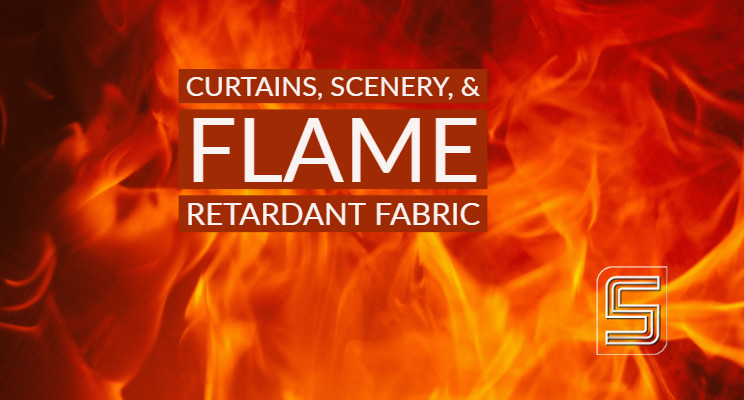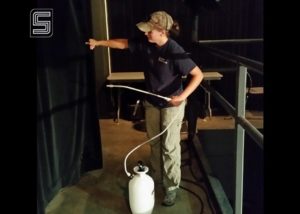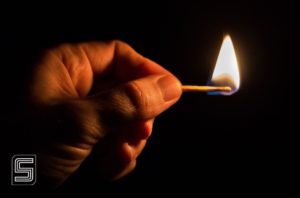
Today is Fire Prevention Day, a good day to think about flame retardant and how it relates to our industry. The information presented here is based on standards from the National Fire Protection Association (NPFA) and industry best practices. It’s important to note that following these guidelines may not be enough to meet the requirements of your local fire marshal. It’s always wise to check with the authority having jurisdiction, prior to having an inspection. It will save time and money.
The primary goal of flame retardant fabrics is to stop the spread of flame. The NPFA publishes two standards for testing flame resistance:
- NFPA 701: Standard Methods of Fire Tests for Flame Propagation of Textiles and Films. This standard specifies a lab test that limits the allowable burn characteristics of a fabric.
- NFPA 705: Recommended Practice for a Field Flame Test for Textiles and Films. This standard specifies a field test (match test) that makes testing on location practical.
Depending on how they are expected to react to flame, all curtain and drapery fabrics are rated into one of four groups. These fabrics are typically given a flame resistance rating when they ship from the mill:
- NFR or Non Flame Retardant: Any fabric that does not meet the requirements of fire codes.
- FR or Flame Retardant: Flame retardant has been applied to NFR fabric by dipping or spraying. This fabric has an expiration date. In addition, if the fabric gets wet the flame retardant will wash away and the fabric will need to be retreated.
- IFR or Inherently Flame Retardant: These fabrics have flame resistant properties built into the weave of the fabric. Early examples had fiberglass or asbestos content. Today’s fabrics utilize polymer extruded nylon and polyester in most cases. These fabrics can be washed and do not lose their flame retardant properties. Though flame resistant, these fabrics can ignite; however, they must self-extinguish when the heat source is removed. This fabric does not have an expiration date.
- DFR or Durably Flame Retardant: These fabrics are inherently flame retardant as well, but have properties that will remain fire resistant for the life of the fabric.
There are also fabrics that are used as heat stop fabrics. They have a rated temperature varying from 600 degrees Fahrenheit to 1800 degrees Fahrenheit. They are most often used to insulate electrics from softgoods hanging on nearby linesets. These fabrics can have ratings from flame retardant to durably flame retardant, so be sure to read the manufacturer’s tag and know your limits.
It’s important to keep your house clean – including your curtains. Dust can be flammable. Allowing it to build up on your curtains reduces the effectiveness of their flame retardancy. At least once a year, shake your curtains out and then use a soft bristle broom to brush off remaining dust. This is also a good excuse to buy some new brooms each year.

Scheduling the retreatment of curtains will have a varying cycle depending on the curtains, theatre, climate and local laws. We recommend that curtains be inspected annually and retreated every 3 years at a minimum.
(A Scenic Solutions crew member retreats some drapes)
But what about the rest of the show? Scenery often has a high wood content, and must not be overlooked. The easiest rule of thumb is to make sure that all exposed surfaces are painted. Rosco makes a paint additive, Roscoflamex PA, that can be used in latex paints. Roscoflamex has been tested to meet the ASTM E-84 Standard Test Method for Surface Burning Characteristics of Building Materials. There is no field test that meets this standard. And remember to consult your local fire marshal for their preferred test method.
TEST FOR EFFECTIVE FIRE RETARDANT TREATMENT

4.1 Materials
4.1.1 Specimens should be samples removed from the existing materials.
4.1.2 Specimens should be dry and should be a minimum of 1/2 in x 4 in (12.7mm x 101.6mm)
4.2 Open Flame. The fire exposure should be from a common wood kitchen match or source with equivalent flame properties.
4.2.1 Flame should be applied for 12 seconds.
4.3 Method
4.3.1 The test should be performed in a draft-free and safe location free of other combustibles.
4.3.2 The sample should be suspended (preferably by means of a spring clip, tongs, or similar device) with the long axis vertical, the flame supplied to the center of the bottom edge, and the bottom edge 1/2 in (12.7mm) above the bottom of the flame.
4.3.3 After 12 seconds of exposure, the match is to be removed gently away from the sample.
4.4 Requirements
4.4.1 There should not be more than 2 seconds of afterflame
4.4.2 Materials that break or drip flaming particles should be rejected if the materials continue to burn after they reach the floor.



